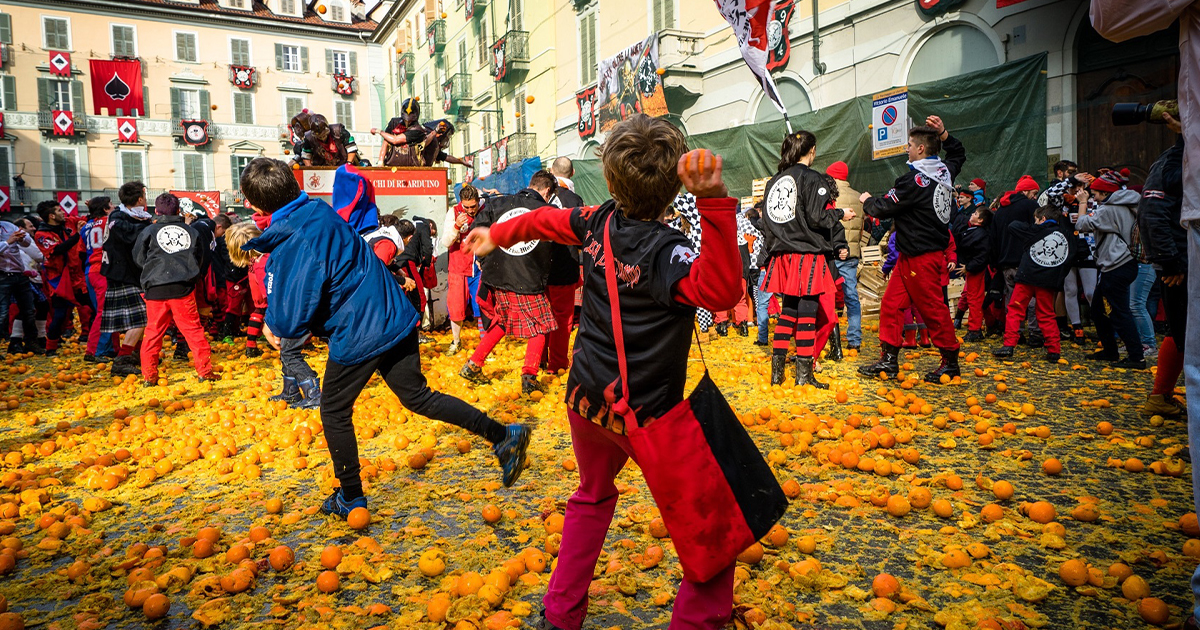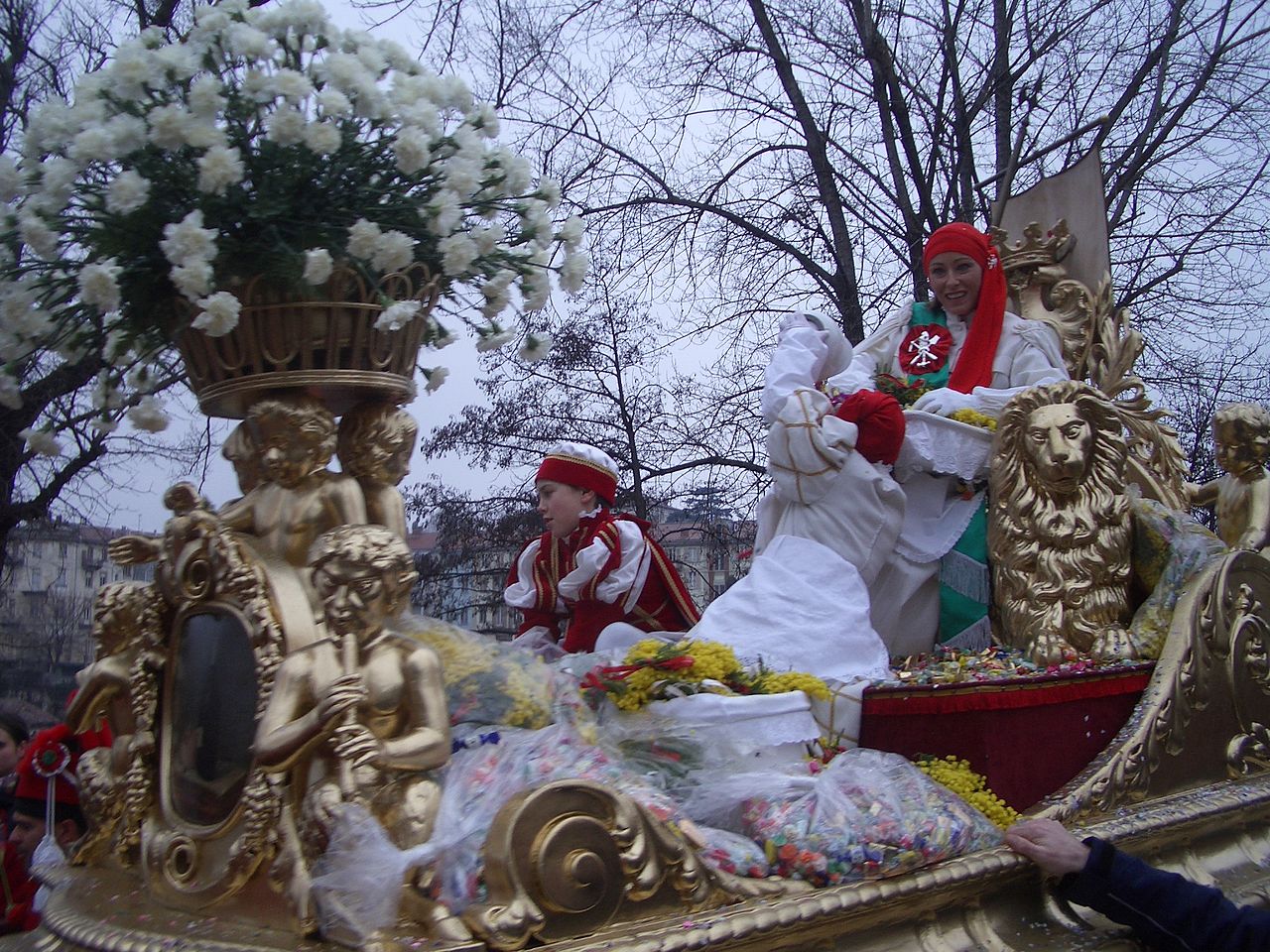The Battle Of The Oranges
The carnival in Ivrea is one of Italy’s oldest festivals. While most carnivals end with a Mardi Gras that’s basically one final epic party, the folks in Ivrea end Carnival with something a little more aggressive: The Battle of the Oranges.
While taking part in Italy’s largest food fight may sound fun, the origins of this tradition are anything but.

Where Is The Battle Of The Oranges?
Ivrea is a small town in northern Italy’s Piedmont region. About 23,000 people live there. Each year, nearly 7,000 people gather in the city center to take part in the Battle of the Oranges.
 Vfbia, CC BY-SA 4.0, Wikimedia Commons
Vfbia, CC BY-SA 4.0, Wikimedia Commons
The Origins Of The Battle
The inspiration for the Battle of the Oranges is said to date back to the Middle Ages, during the 1100s. At the time, Ivrea was governed by a tyrant who had a particularly vile way of exerting his power.
The Revolution
According to the story, the tyrant abducted a miller’s daughter named Violetta on the eve of her wedding. He tried to assault her, but the young woman beheaded him. When the people of Ivrea saw what she’d done, it sparked a revolution, and they burned the tyrant’s palace to the ground.
 Fondazione Torino Musei, CC BY 3.0 IT, Wikimedia Commons
Fondazione Torino Musei, CC BY 3.0 IT, Wikimedia Commons
Acting Out The Past
The Battle of the Oranges commemorates this revolt against tyrannical power. Each year, a woman is chosen to play the part of the miller’s daughter, or La Mugnaia. Thousands of townsfolk come to La Mugnaia’s aid, dressed as soldiers and armed with oranges.
The Aranceri
The battle has been an annual tradition in Ivrea since 1947. For three days, from Sunday to Mardi Gras Tuesday, nine teams of aranceri (meaning “orange-throwers”) duke it out in the streets of Ivrea.
The aranceri on foot represent the angry villagers, while the aranceri who ride in horse-drawn carts represent the tyrants forces.
 Vfbia, CC BY-SA 4.0, Wikimedia Commons
Vfbia, CC BY-SA 4.0, Wikimedia Commons
Defend Your Square
Each team of aranceri villagers controls a piazza, or public square, in the town. They defend their piazzas against the aranceri in the chariots.
Though it may seem like just a food fight, people truly embody the spirit of the revolt, and hurl the oranges at each other with all their might.
Why Do They Throw Oranges?
No one really knows why oranges are the chosen weapon of choice. They became part of the tradition later on in the 19th century and represent the stones that the villagers threw at the tyrant’s palace.
 Pmk58, CC BY-SA 4.0, Wikimedia Commons
Pmk58, CC BY-SA 4.0, Wikimedia Commons
The Original Fruit
In the first years of the battle, people threw beans at each other. Later, they used apples before settling on oranges. Beans are still an important part of Ivrea’s Carnival, and their use is the early days of the festival is commemorated by free servings of a bean dish called fagioli grassi.
Why Beans?
Beans were the weapon of choice in the early years of the festival because they represented the villagers’ contempt for the tyrant.
In some stories of the rebellion, the tyrant gave poor families a pot of boiled beans to eat so they wouldn’t starve. He only did this twice each year, so people took to throwing beans as a way to show their anger at the tyrant’s disrespectful actions.
Festival Food
At the carnival, fagioli grassi is the main dish. It's made in large cauldrons by combining beans, sausages, and bacon rind.
Other traditional dishes at the festival include cured salami called salam duja and cabbage rolls called capunet.
 Yozh, CC BY-SA 4.0, Wikimedia Commons
Yozh, CC BY-SA 4.0, Wikimedia Commons
A Gathering Storm
There are 51 horse-drawn carts, and they’re divided into 35 pairs. Their carts are decorated with bold images and signs. The aranceri on horses gather around 1pm. When they split up to head to the piazzas, everyone know the battle will begin soon.
How Many Oranges Are Used?
Over 600 tons of oranges are used as ammo during the battle. That’s the equivalent of 4 million oranges.
Luckily, the oranges aren’t suitable to be sold, so it’s not a waste of food that people would normally eat.
A Big Mess
The sheer volume of smashed oranges on the streets can be as deep as 40 cm (15 inches). Each night, the streets are cleaned after the battle, and ready to get covered in the sticky fruit all over again the next day.
Sustainability
The oranges that are used during the fight are ones that wouldn’t be sold for eating. They’d be used for pulping so smashing them at people on the street is kind of similar to where they’d end up anyway. The farmers are also paid for the oranges.
Another Use For The Oranges
At the end of each day of the battle, the smashed oranges are collected in a special tank. When the Battle of the Oranges comes to an end, all of the fruit is transported to a disposal plant whether it is turned into compost.
 Lupo, CC BY-SA 2.5, Wikimedia Commons
Lupo, CC BY-SA 2.5, Wikimedia Commons
Important Preparations
Preparations for the Battle of the Oranges start in January, a month before the carnival. The town elects someone to play the role of Generale.
The Generale is the master of ceremonies, and he begins the carnival festivities with a masquerade ball on the evening before the battle.
 Ambra75, CC BY-SA 4.0, Wikimedia Commons
Ambra75, CC BY-SA 4.0, Wikimedia Commons
The Most Important Role
The role of La Mugnaia is also chosen in January, though her identity is kept a secret until the eve of the battle. That’s when the person playing La Mugnaia is finally revealed and paraded through the streets in a golden carriage.
She wears a white wedding dress, and the crowd often throws candies and small mimosa branches in celebration.
The Abbà
In addition to the Generale and La Mugnaia, the Abbà also have an important role to play in the festivities.
The Abbà are a group of 10 children who dress in Renaissance costumes to represent the five parishes in Ivrea. They join the Generale at the opening ball.
Joining In On The Fun
Anyone can participate in the battle, but depending on which team you join, the participation fee will cost up to 120 euros. Food, wine, and all the oranges you can throw during the three-day festival are included in the participation fee.
Reservations for non-locals and those who haven’t been to the festival before usually open in January.
 Giò, CC BY 2.0, Wikimedia Commons
Giò, CC BY 2.0, Wikimedia Commons
Reservations For The Battle
When it comes to reserving a spot for the battle, this is usually done in-person. Some teams will let you sign up via email or make an exception for special case, but each team has their own rules about registration.
It’s also common for rules to differ between experienced aranceri and first-timers, so check the teams’ websites for details.
The Uniform
If you’re a newcomer, you’ll also have to buy a uniform, called a divisa. This can cost another 50 euros to 80 euros, but you get to keep the divisa after the battle and use it again.
It’s common for people to sew patches representing the different years of the carnival onto their divisas, leaving them with a record of all the orange battles they’ve been in.
 Jayapura, CC BY 3.0, Wikimedia Commons
Jayapura, CC BY 3.0, Wikimedia Commons
At The Sound Of The Whistle
The sound of the whistle signals the beginning and end of the battle. It also lets participants know when they can put their oranges down and take a breather before the next round of fighting.
 Vfbia, CC BY-SA 4.0, Wikimedia Commons
Vfbia, CC BY-SA 4.0, Wikimedia Commons
Safety During The Battle
Safety nets are put around the buildings near the piazzas, so spectators can watch the battle without becoming collateral damage.
During the battle you’ll see many people wearing big red Phrygian hats. Anyone wearing one of the hats is off-limits and can’t be attacked by the aranceri.
Final Thoughts
The Battle of the Oranges is one the most unique and spirited traditions in the world. From its medieval origins to the zest-filled battlegrounds of today, this citrus-infused spectacle is sure to brings people together in a celebration of history and camaraderie for years to come.





















